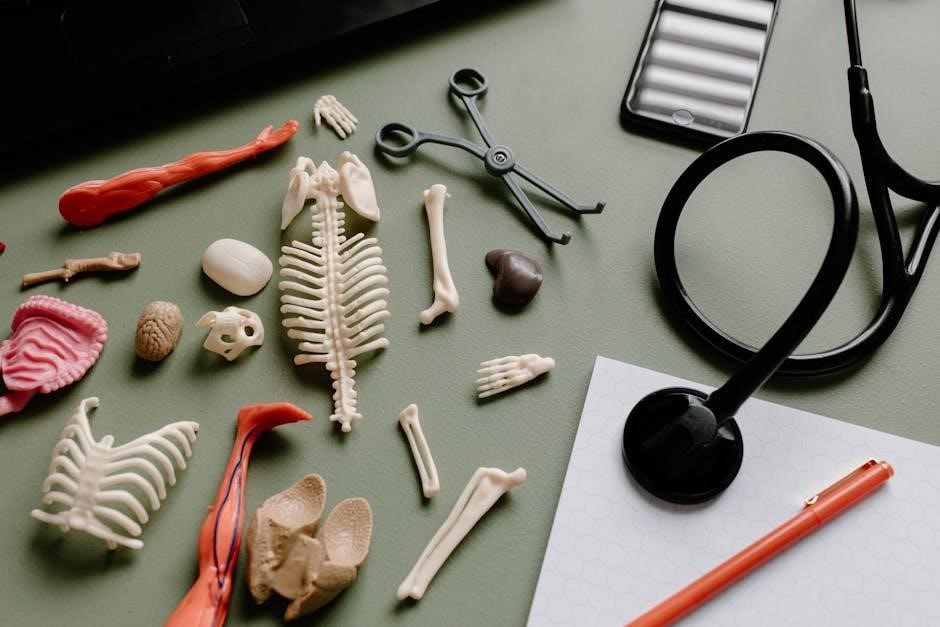Medical-Surgical Nursing Study Guide
Elevate your medical-surgical nursing expertise with comprehensive study guides. These resources provide in-depth reviews‚ practice questions‚ and case studies. Master essential concepts‚ hone critical thinking‚ and prepare confidently for certification exams. Succeed in med-surg nursing!
Medical-surgical nursing forms the bedrock of adult healthcare‚ encompassing a wide array of medical conditions and surgical interventions. It demands a holistic approach‚ blending scientific knowledge with compassionate care. Nurses in this field require critical thinking‚ problem-solving prowess‚ and adept clinical judgment to navigate complex patient scenarios.
This dynamic specialty requires constant learning and adaptation as medical advancements evolve. A strong understanding of anatomy‚ physiology‚ and pathophysiology is crucial for effective assessment‚ diagnosis‚ and treatment planning. Medical-surgical nurses are responsible for monitoring patients‚ administering medications‚ managing wounds‚ and educating patients and their families.
Effective communication and collaboration are essential‚ involving interdisciplinary teams to ensure comprehensive patient care. This includes physicians‚ therapists‚ pharmacists‚ and other healthcare professionals. The ability to advocate for patients and provide emotional support is also paramount.
This study guide serves as a valuable tool for students and practicing nurses to enhance their knowledge and skills in this ever-evolving field‚ preparing them for the challenges and rewards of medical-surgical nursing. Resources like this are designed to support your learning and exam preparation. Whether you’re a student or a practicing nurse‚ these resources will help you excel in your field.

Core Concepts in Med-Surg Nursing
Medical-surgical nursing hinges on several core concepts that guide clinical practice. Patient-centered care is paramount‚ emphasizing individual needs and preferences. Safety remains a top priority‚ requiring vigilant monitoring and adherence to protocols. Evidence-based practice ensures interventions are grounded in research and best practices. Quality improvement drives continuous efforts to enhance patient outcomes and optimize processes.
Critical thinking is essential for analyzing patient data‚ identifying potential problems‚ and implementing appropriate interventions. Clinical judgment involves making sound decisions based on knowledge‚ experience‚ and ethical considerations. Effective communication fosters collaboration and ensures clear information exchange among healthcare team members‚ patients‚ and families.
These core concepts interweave to form the foundation of medical-surgical nursing. Nurses must integrate them seamlessly into their daily practice to provide safe‚ effective‚ and compassionate care. Mastering these principles is crucial for success in this dynamic specialty. Understanding these fundamental concepts allows nurses to provide holistic care that addresses the physical‚ emotional‚ and psychosocial needs of patients. It promotes a culture of safety‚ continuous learning‚ and patient advocacy within the healthcare environment.
This section will explore each of these concepts in detail‚ providing practical examples and strategies for implementation.
Fluid and Electrolyte Balance
Maintaining fluid and electrolyte balance is crucial in medical-surgical nursing. This delicate equilibrium ensures optimal cellular function and overall physiological stability. Fluid balance involves regulating the volume and distribution of body fluids‚ including intracellular‚ extracellular‚ and intravascular compartments. Electrolytes‚ such as sodium‚ potassium‚ calcium‚ and magnesium‚ play vital roles in nerve impulse transmission‚ muscle contraction‚ and maintaining acid-base balance.
Imbalances in fluid and electrolytes can arise from various factors‚ including illness‚ injury‚ medications‚ and inadequate intake. Dehydration‚ overhydration‚ and electrolyte deficiencies or excesses can lead to serious complications. Recognizing the signs and symptoms of these imbalances is essential for prompt intervention.
Nursing interventions focus on restoring and maintaining fluid and electrolyte balance. This includes monitoring fluid intake and output‚ administering intravenous fluids and electrolytes as prescribed‚ and educating patients about proper hydration and dietary sources of electrolytes. Careful assessment‚ accurate documentation‚ and timely communication with the healthcare team are crucial for effective management.
Understanding the underlying mechanisms of fluid and electrolyte regulation is paramount for nurses to provide safe and effective care to medical-surgical patients. This section will delve into the specifics of each electrolyte‚ common imbalances‚ and appropriate nursing interventions.

Acid-Base Imbalances
Acid-base balance is a critical aspect of homeostasis‚ essential for optimal cellular function. This balance is maintained by complex regulatory mechanisms involving the lungs‚ kidneys‚ and buffer systems. An imbalance occurs when the body’s pH deviates from the normal range of 7.35 to 7.45‚ leading to either acidosis (excess acid) or alkalosis (excess base).
Respiratory and metabolic processes primarily influence acid-base balance. Respiratory acidosis results from inadequate ventilation‚ causing carbon dioxide retention. Respiratory alkalosis arises from excessive ventilation‚ leading to carbon dioxide loss. Metabolic acidosis occurs due to an accumulation of acids or a loss of bicarbonate. Metabolic alkalosis results from an excess of bicarbonate or a loss of acids.
Identifying the underlying cause of an acid-base imbalance is crucial for appropriate treatment. Arterial blood gas (ABG) analysis is a vital diagnostic tool‚ providing information about pH‚ PaCO2‚ HCO3-‚ and PaO2. Treatment strategies vary depending on the specific imbalance and may include oxygen therapy‚ mechanical ventilation‚ fluid and electrolyte replacement‚ or medication administration.

Nurses play a critical role in monitoring patients at risk for acid-base imbalances‚ such as those with respiratory or renal disorders. Understanding the pathophysiology‚ assessment findings‚ and treatment modalities is essential for providing effective nursing care and preventing complications. This section will provide a detailed exploration of acid-base imbalances.
Infection Control and Prevention
Infection control and prevention are paramount in healthcare settings to protect patients‚ healthcare workers‚ and visitors from infectious agents. Healthcare-associated infections (HAIs) are a significant concern‚ contributing to increased morbidity‚ mortality‚ and healthcare costs. Implementing effective infection control practices is essential for minimizing the risk of HAIs.
Standard precautions are the foundation of infection control‚ applying to all patients regardless of suspected or confirmed infection status. These precautions include hand hygiene‚ use of personal protective equipment (PPE)‚ safe injection practices‚ and proper handling of contaminated equipment and linens. Transmission-based precautions are implemented when specific infections are suspected or confirmed‚ including contact‚ droplet‚ and airborne precautions.
Hand hygiene is the single most effective measure to prevent the spread of infection. Healthcare workers should perform hand hygiene before and after patient contact‚ after removing gloves‚ and after contact with potentially contaminated surfaces. PPE‚ such as gloves‚ gowns‚ masks‚ and eye protection‚ should be used when there is a risk of exposure to blood‚ body fluids‚ or infectious agents.
Environmental cleaning and disinfection are crucial for reducing the number of pathogens in the healthcare environment. Proper disposal of sharps and contaminated waste is essential to prevent needlestick injuries and the spread of infection. Nurses play a vital role in promoting and implementing infection control practices‚ educating patients and families‚ and monitoring for signs and symptoms of infection.
Pain Management Strategies
Effective pain management is a crucial aspect of medical-surgical nursing‚ aimed at improving patient comfort‚ function‚ and overall quality of life. Pain can be acute or chronic‚ and its management requires a comprehensive and individualized approach. Nurses play a central role in assessing‚ planning‚ implementing‚ and evaluating pain management strategies.
A thorough pain assessment is the first step in developing an effective pain management plan. This includes assessing the location‚ intensity‚ quality‚ and duration of pain‚ as well as factors that exacerbate or relieve it. Non-pharmacological interventions‚ such as heat or cold application‚ massage‚ relaxation techniques‚ and distraction‚ can be used alone or in combination with pharmacological approaches.
Pharmacological interventions include opioid and non-opioid analgesics‚ as well as adjuvant medications. Opioids are effective for managing severe pain but carry risks of side effects such as constipation‚ nausea‚ and respiratory depression. Non-opioid analgesics‚ such as acetaminophen and NSAIDs‚ are useful for mild to moderate pain. Adjuvant medications‚ such as antidepressants and anticonvulsants‚ can be used to treat neuropathic pain.
Patient education is an essential component of pain management. Patients should be educated about their pain management plan‚ including the medications they are taking‚ potential side effects‚ and non-pharmacological strategies they can use. Regular monitoring and evaluation of pain management effectiveness are necessary to adjust the plan as needed. The goal is to achieve optimal pain control while minimizing side effects.
Respiratory Disorders
Respiratory disorders encompass a wide range of conditions affecting the lungs and airways‚ impacting oxygenation and ventilation. Medical-surgical nurses play a critical role in the assessment‚ management‚ and education of patients with these conditions. Understanding the pathophysiology‚ clinical manifestations‚ and treatment modalities for common respiratory disorders is essential for providing effective nursing care.
Asthma‚ a chronic inflammatory disease of the airways‚ causes bronchoconstriction‚ inflammation‚ and mucus production‚ leading to wheezing‚ shortness of breath‚ and chest tightness. Chronic obstructive pulmonary disease (COPD)‚ including emphysema and chronic bronchitis‚ is characterized by airflow limitation and progressive lung damage‚ often associated with smoking. Pneumonia‚ an infection of the lungs‚ causes inflammation and fluid accumulation‚ leading to cough‚ fever‚ and difficulty breathing.
Other respiratory disorders include pulmonary embolism‚ a blockage of pulmonary arteries; pneumothorax‚ air accumulation in the pleural space; and acute respiratory distress syndrome (ARDS)‚ a severe lung injury causing widespread inflammation and fluid leakage. Nurses assess respiratory status through auscultation‚ monitoring oxygen saturation‚ and evaluating breathing patterns. Interventions include oxygen therapy‚ medication administration‚ airway management‚ and promoting effective coughing and deep breathing.
Patient education focuses on disease management‚ medication adherence‚ smoking cessation‚ and strategies to prevent respiratory infections. Nurses also provide emotional support and address psychosocial concerns related to chronic respiratory conditions. Collaboration with respiratory therapists and other healthcare professionals is crucial for optimizing patient outcomes.
Cardiovascular Disorders
Cardiovascular disorders represent a significant portion of medical-surgical nursing practice‚ encompassing a wide spectrum of conditions affecting the heart and blood vessels. Nurses play a pivotal role in the assessment‚ management‚ and education of patients with cardiovascular diseases‚ aiming to prevent complications and improve quality of life. A strong understanding of cardiovascular pathophysiology is essential.
Coronary artery disease (CAD)‚ characterized by atherosclerosis‚ leads to reduced blood flow to the heart muscle‚ causing angina or myocardial infarction. Heart failure‚ a chronic condition where the heart cannot pump enough blood‚ results in fluid retention‚ shortness of breath‚ and fatigue. Arrhythmias‚ or irregular heartbeats‚ can range from benign to life-threatening‚ requiring careful monitoring and intervention.
Hypertension‚ or high blood pressure‚ is a major risk factor for cardiovascular disease‚ often requiring lifestyle modifications and medication management. Peripheral artery disease (PAD) affects blood flow to the extremities‚ causing pain and increasing the risk of amputation. Venous thromboembolism (VTE)‚ including deep vein thrombosis (DVT) and pulmonary embolism (PE)‚ involves blood clot formation in the veins‚ requiring anticoagulation therapy.
Nurses assess cardiovascular status through vital signs monitoring‚ ECG interpretation‚ and physical examination. Interventions include medication administration‚ lifestyle counseling‚ and patient education on risk factor modification. Cardiac rehabilitation programs help patients recover after cardiac events. Nurses also provide emotional support to patients and families coping with chronic cardiovascular conditions.
Gastrointestinal Disorders
Gastrointestinal (GI) disorders are a prevalent concern in medical-surgical nursing‚ encompassing a wide array of conditions affecting the digestive system. Nurses play a crucial role in assessing‚ managing‚ and educating patients with GI disorders‚ striving to alleviate symptoms‚ prevent complications‚ and promote optimal nutrition. A comprehensive understanding of GI anatomy and physiology is paramount.
Peptic ulcer disease (PUD)‚ characterized by sores in the stomach or duodenum‚ often results from Helicobacter pylori infection or NSAID use. Inflammatory bowel disease (IBD)‚ including Crohn’s disease and ulcerative colitis‚ involves chronic inflammation of the GI tract‚ leading to abdominal pain‚ diarrhea‚ and weight loss. Irritable bowel syndrome (IBS)‚ a functional GI disorder‚ causes abdominal discomfort and altered bowel habits.
Gastroesophageal reflux disease (GERD) occurs when stomach acid flows back into the esophagus‚ causing heartburn and potential damage. Hepatitis‚ an inflammation of the liver‚ can result from viral infections‚ alcohol abuse‚ or drug toxicity. Cirrhosis‚ a chronic liver disease‚ leads to scarring and impaired liver function. Pancreatitis‚ an inflammation of the pancreas‚ causes severe abdominal pain and digestive enzyme dysfunction.
Nurses assess GI function through abdominal examinations‚ stool sample analysis‚ and review of dietary habits. Interventions include medication administration‚ nutritional support‚ and patient education on dietary modifications. Ostomy care is essential for patients with bowel resections. Nurses also provide emotional support to patients and families coping with chronic GI conditions and their impact on quality of life.
Endocrine Disorders
Endocrine disorders disrupt the delicate balance of hormones‚ impacting various bodily functions. Medical-surgical nurses must possess a strong understanding of these disorders to provide effective patient care. Diabetes mellitus‚ a prevalent endocrine disorder‚ involves impaired glucose regulation‚ leading to hyperglycemia and potential complications like neuropathy‚ nephropathy‚ and cardiovascular disease.
Hyperthyroidism‚ characterized by excessive thyroid hormone production‚ causes symptoms such as weight loss‚ anxiety‚ and rapid heart rate. Conversely‚ hypothyroidism‚ resulting from insufficient thyroid hormone‚ leads to fatigue‚ weight gain‚ and cognitive impairment. Cushing’s syndrome‚ caused by prolonged exposure to high cortisol levels‚ manifests as weight gain‚ muscle weakness‚ and skin changes.
Addison’s disease‚ characterized by adrenal insufficiency‚ results in fatigue‚ weakness‚ and electrolyte imbalances. Diabetes insipidus‚ caused by a deficiency in antidiuretic hormone (ADH)‚ leads to excessive thirst and urination. Syndrome of inappropriate antidiuretic hormone secretion (SIADH) involves excessive ADH production‚ causing fluid retention and hyponatremia.
Nurses assess endocrine function through hormone level monitoring‚ physical examinations‚ and evaluation of patient symptoms. Interventions include medication administration‚ blood glucose monitoring‚ and patient education on lifestyle modifications. Nurses also provide support to patients coping with the emotional and physical challenges of endocrine disorders‚ promoting self-management and improving quality of life. Understanding these complex conditions is vital for medical-surgical nurses.
Neurological Disorders

Neurological disorders encompass a wide range of conditions affecting the brain‚ spinal cord‚ and peripheral nerves. Medical-surgical nurses play a crucial role in caring for patients with these disorders‚ requiring a strong understanding of neurological assessment and interventions. Stroke‚ a leading cause of disability‚ results from interruption of blood flow to the brain‚ leading to neurological deficits such as weakness‚ speech difficulties‚ and cognitive impairment.
Multiple sclerosis (MS)‚ an autoimmune disease‚ affects the myelin sheath surrounding nerve fibers‚ causing a variety of symptoms including fatigue‚ muscle weakness‚ and vision problems. Parkinson’s disease‚ a progressive neurodegenerative disorder‚ affects movement‚ causing tremors‚ rigidity‚ and bradykinesia. Alzheimer’s disease‚ the most common form of dementia‚ leads to progressive cognitive decline and memory loss.
Epilepsy‚ characterized by recurrent seizures‚ requires careful monitoring and medication management. Traumatic brain injury (TBI) can result in a range of neurological deficits depending on the severity of the injury. Spinal cord injuries (SCI) can lead to paralysis and sensory loss below the level of the injury. Meningitis‚ an infection of the meninges surrounding the brain and spinal cord‚ requires prompt diagnosis and treatment.
Nurses assess neurological function through cranial nerve assessment‚ motor and sensory testing‚ and evaluation of cognitive function. Interventions include medication administration‚ seizure precautions‚ and rehabilitation therapies. Nurses also provide support to patients and families coping with the challenges of neurological disorders‚ promoting independence and improving quality of life.
NCLEX-Style Practice Questions
Musculoskeletal Disorders
Musculoskeletal disorders affect bones‚ joints‚ muscles‚ tendons‚ and ligaments‚ impacting mobility and quality of life. Medical-surgical nurses provide comprehensive care for patients with these conditions‚ requiring knowledge of anatomy‚ physiology‚ and common musculoskeletal diseases. Osteoarthritis (OA)‚ a degenerative joint disease‚ causes pain‚ stiffness‚ and limited range of motion. Rheumatoid arthritis (RA)‚ an autoimmune disorder‚ affects the joints‚ causing inflammation‚ pain‚ and deformity.
Osteoporosis‚ characterized by decreased bone density‚ increases the risk of fractures. Fractures‚ breaks in bones‚ require immobilization and pain management. Gout‚ a type of arthritis‚ results from uric acid crystal buildup in joints‚ causing intense pain and inflammation. Muscular dystrophy‚ a group of genetic disorders‚ causes progressive muscle weakness and degeneration.
Back pain‚ a common musculoskeletal complaint‚ can result from muscle strain‚ disc herniation‚ or spinal stenosis. Carpal tunnel syndrome‚ caused by compression of the median nerve in the wrist‚ leads to pain‚ numbness‚ and tingling in the hand. Nurses assess musculoskeletal function through range of motion testing‚ strength assessment‚ and pain evaluation. Interventions include pain management‚ assistive devices‚ and rehabilitation therapies.
Patient education focuses on fall prevention‚ weight management‚ and exercise. Nurses also provide support to patients and families coping with chronic musculoskeletal conditions‚ promoting independence and improving functional abilities. Understanding the pathophysiology‚ assessment‚ and management of musculoskeletal disorders is essential for medical-surgical nurses to provide effective and compassionate care.
